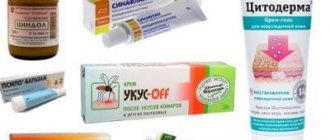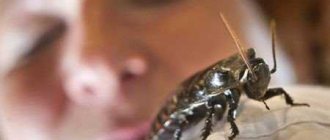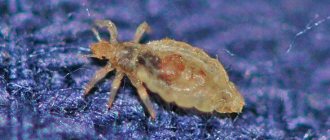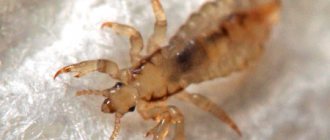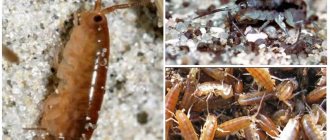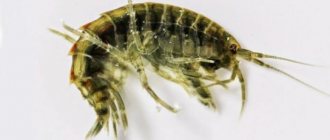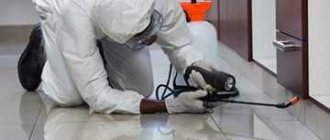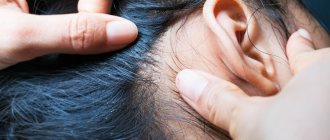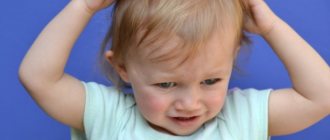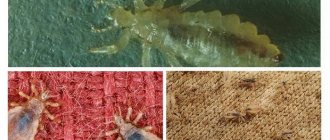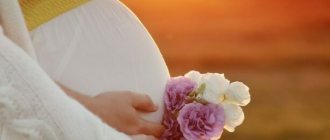Linen lice are one of the many parasitic insects that use human blood as food. They have adapted to live outside the body of people, living on dirty clothes and underwear. Bloodsuckers sometimes crawl onto the skin to bite and feed on a person’s blood. Most often they attack the lower back, neck, abdomen and armpits. This article will tell you what linen lice bites look like and why they are dangerous to humans.
Symptoms of linen lice
The presence of parasites can only be determined by bites on the body. Insects feed on blood and eat in most cases at night, when a person is in bed. The process of food absorption lasts up to 3 minutes, the frequency of bites is several times a week. Linen lice, unlike head lice, do not live on the body; they crawl there only to feed. If there is no food source for 7 days, the insects die.
The parasite injects a special substance that prevents blood clotting. With frequent bites, an allergic reaction and inflammation develop. When scratching, an infection gets into the wound and ulcers appear. Therefore, the symptoms of linen lice on the skin depend on the stage of infection and the number of parasites.
Insects settle in linen, mattresses, and underwear. In places where the power source is closest. Externally they resemble a head louse. The body size of an adult is up to 5 mm, the body is translucent. Elastic chitinous cover, capable of stretching. Nits are white, oblong in shape, up to 2 mm. Lice lay eggs in linen, bedding, and folds of clothing.
How dangerous are lice?
In addition to bites and inflammation, parasites are sources of dangerous infectious diseases that are difficult to tolerate and fatal. They enter the body through bites and remaining wounds on the body.
Main emerging diseases:
- Typhus - appears directly from body lice bites. Bacteria, when scratching the affected area, penetrate into the blood. Its symptoms are fever, specific rashes, headache.
- Relapsing fever is a severe acute disease transmitted by parasites. Symptoms are similar to typhus, but with the addition of delirium, enlarged liver and spleen.
- Trench fever is an infectious disease characterized by a rash and muscle pain. Infection occurs through the feces of infected insects into wounds.
- Sepsis - occurs from the penetration of bacteria into wounds after bites during scratching and unsanitary conditions. Accompanied by suppuration of the skin, ulcers, fever, chills, and blood poisoning.
- Pediculosis is a parasitic disease accompanied by severe itching, skin damage, and the formation of boils when the infection gets deep into the skin.
- Tularemia is a focal infection that affects the lymph nodes, skin and lungs. It occurs with symptoms of intoxication, fever, the appearance of festering buboes, ulcers and rashes. Its causative agent is the tularemia bacillus, which is carried by the bed louse.
- Allergy - occurs as a result of the introduction of a substance released when a louse bites. Characterized by redness, itching, inflammation.
Linen lice bites on the body, photo
Single bites are no different from a midge, mosquito, or bed bug. At the site of saliva injection, slight swelling and redness appear, and itching appears over time. There is a dark spot of dried blood in the center.
Currently reading: Nervous lice - can they appear?
With severe infection, there are many spots, they are located chaotically, often merge into one huge spot or look like a rash. Insects bite in areas where blood vessels are located closer to the surface - legs, shoulders, back, arms, neck. Less often the stomach. Adults are not bitten on the head; in children, bites are found on the face. Parasites do not live in the scalp.
Prevention
In order to minimize the risk of infection, precautions should be taken, namely:
- • regular washing of the head and body, adherence to general hygiene rules;
- • regular examination of the child's head, especially if he attends school or kindergarten;
- • familiarizing children with the rules of hygiene and maintaining a safe distance when playing and communicating;
- • regular change of bedding - to prevent infestation with body lice;
- • exclusion of casual sexual relations in order to prevent infection with pubic lice;
- • applying drops of tea tree oil or lavender behind the ears, the smell of these products repels insects
Unfortunately, following normal hygiene rules does not guarantee complete protection against lice infestation. The main method of prevention is maintaining a safe distance when communicating with people whose appearance is suspicious.
What body lice bites look like on the body, photo
Lice that live in things, bedding, and clothing have several names - linen lice, body lice, clothing lice, clothing lice. Nests are formed by insects in folds of fabric, blankets, mattresses, and underwear, but there is no difference between these parasites.
The symptoms are similar. Infection can occur at any time of the year, therefore, if itchy spots or swellings are detected, it is necessary to examine the head and bed.
Linen bug bites, photo
Insects do not live in the wild; they live only in human habitation. Infection can occur at any time of the year. They get into the house with infected things or from neighbors through cracks in the wall, floor, sockets, wiring, ventilation shafts. They differ in appearance from linen fleas, but their lifestyle is similar.
Bedbugs settle closer to the sleeping area, but do not necessarily settle in the bed. These can be sockets, books, interior items, wallpaper, household appliances, and much more. They crawl out of their shelters at night and attack a sleeping person. Bites appear on the neck, shoulders, arms, back, legs. They often bite in open areas.
Adults feed once every 10 days, nymphs of different ages feed every 3 days. During the bite, a substance is injected that prevents blood clotting. Adult bedbugs contain pain-relieving components in their saliva, so people do not hear the bite itself. Symptoms appear in the morning.
Bed bugs pierce the skin in a certain sequence - 2 bites in the form of a path. There is inflammation, swelling, redness, and dried blood in the center. With severe infection, large spots and allergies form.
Head louse
This is the most famous subspecies of this parasite, as many have suffered from it. Bites are detected quite easily. At first they look like normal redness, but as the colony grows and the lice feed, they merge into bluish spots.
Typically, bites can be found between the hair, as well as behind the ears and on the part of the neck where the hair ends. In men, lice can live in the beard and mustache, if any. In some cases, these parasites can even live in eyelashes or eyebrows, but such cases are rather the exception and show that the infection is already very strong.
Treatment methods are more varied in comparison with the pubic and veil subtypes. But, the main method is still shaving the hair from the head. If this method is not considered, then you need to purchase a special anti-lice shampoo at the pharmacy and use it. It is also necessary to comb your hair with a fine comb to remove nits from it.
ATTENTION: When infected with any type of lice, you need to examine your neighbors in the apartment to exclude their infection, or to take timely treatment measures. Inspections are carried out four times a month, every ten days.
How long do lice bites itch?
Bites can itch for up to three days; this is a purely individual indicator, depending on the body and skin condition, as well as the level of hygiene. The main thing is not to scratch the bites.
Linen flea bites
Small jumping creatures do not live in linen or clothes. They prefer to live under the floor, baseboards, in carpets, near the pet's sleeping place. The flea is dark, almost black in color, jumps well, and bites painfully. It begins to attack in the evening. Bites exposed areas of the body. Often the legs suffer. You can feel the bite immediately, since there is no anesthetic component in the saliva of insects. Redness, a dark spot with dried blood, and severe itching immediately appear. Swelling occurs with multiple bites. They parasitize mainly in the warm season; there are no fleas in winter. They don’t sneak into a sleeping person’s bed.
Currently reading: Incubation period of lice and nits - when to expect replenishment
Destruction of linen lice
Requires general cleaning and mass washing.
- The clothes that the person wore for a month before the bites appeared and if they are present are thrown into the wash, and the bedding is boiled. They wash things at 90 degrees Celsius. Dry outside, iron with steam.
- A person needs to take a shower and choose a means to treat bites. Single spots go away on their own within a week; massive bites require therapy.
- It is recommended to dry clean the mattress or treat it with an insecticidal agent, and after 2 hours take it out into the fresh air for ventilation.
- The house should be disinfested or thoroughly cleaned using special solutions to repel parasites. Linen lice do not live in carpets and soft toys.
If no bites appear on the body within 2 weeks, the operation to destroy parasites can be considered successful. If at least one bite occurs, washing the linen and bedding must be repeated.
Where can you catch the infection?
In order to avoid becoming a victim of dangerous parasites, it is important to understand what methods of infection there may be. The constant carrier of lice is a person with lice to one degree or another.
So, let's look at the main migration routes of lice:
- Contact. In case of close contact with a person with head lice, the lice simply climb onto a new victim, occupying the scalp or items of clothing. It's enough to just lie on one pillow or hug.
- Through care items. It is enough to use a sick person’s towel at least once to feel all the “beauty” of lice. Also at risk: combs, hairpins, washcloths, underwear, scarves, hats, pillows and other bedding. The lion's share of infections occurs on trains and in kindergartens and educational institutions.
- In second-hand or consignment stores. At favorable temperatures, parasites can remain on the clothes of the old “host” and wait for a new victim for several days.
- In a pond or swimming pool. Lice love humidity and live in water for up to 48 hours.
- Sexual path. During intimacy, pubic lice happily change hosts.
Lice spray
There are no special means. Insecticidal aerosols and broad-spectrum sprays are used. Disinsection is carried out throughout the house if the room is heavily infested, or the bed, sofa on which the person slept, or mattress are treated.
The treatment procedure is simple - spray the poison at a distance of 20 cm from the surface and leave for 2 hours. The furniture is wiped with a solution of baking soda and salt to completely neutralize the effect of the insecticide. The mattress should be well aired.
If disinfestation is carried out throughout the apartment, leave the room closed for 2 hours, then carry out general cleaning and ventilate well. To combat linen lice, it is not necessary to use powerful insecticides; you can use any insect repellent aerosol with a wide spectrum of action:
- Raptor;
- Raid;
- Clean house;
- Dichlorvos;
- Karbofos.
You should work in a respirator and rubber gloves. If the product is used incorrectly, poisoning of varying degrees of severity occurs.
Currently reading: Lice on hair (photo) – in dreams and in reality
Treatment of bites
At the initial stage of infection with pediculosis, you can use folk remedies, pharmaceutical drugs with antipruritic, anti-inflammatory properties. If an allergic reaction develops, antihistamine ointments and lotions are used. If the wounds become infected and ulcers form, local antibiotics are used.
Folk remedies for linen lice bites:
First aid supplies:
Antihistamines, antiallergic drugs:
Local antibiotics:
If the condition does not return to normal within 3 days, you should seek help from specialists.
Danger of lice
Pediculosis causes great discomfort. The skin is very itchy, in the evening the tooth enlarges, this is due to the fact that insects are most active at night and in the evening, although they also bite during the day.
Constant itching does not allow a person to relax, concentrate, interferes with normal everyday activities, and puts him in an awkward position in front of other people. This is reflected in the nervous system, constant irritation and stress. A person may suffer from insomnia, poor sleep, constant fatigue, and decreased performance.
When a person scratches the skin, open wounds appear, which become an ideal environment for infection. Secondary infection can lead to the development of various dermatological diseases, which will significantly complicate the general condition.
The substance that the parasite releases during an attack can cause a severe allergic reaction. At the same time, itching significantly increases, irritation, rash, burning, and swelling appear. When a person has allergic reactions, it is necessary to resort to treatment as soon as possible. Antiallergic and antihistamine drugs are often prescribed.
There is another danger: lice are carriers of typhoid fever, a very serious disease. If a person experiences a fever, weakness, or malaise, they should immediately consult a doctor.
